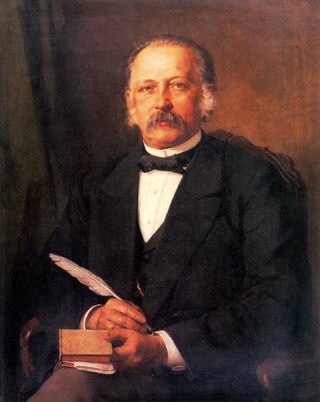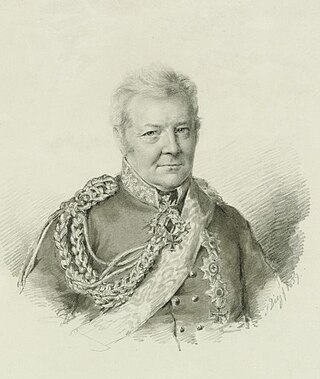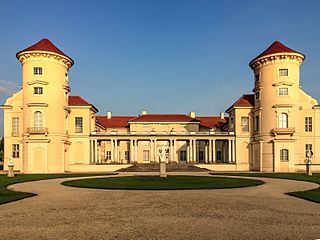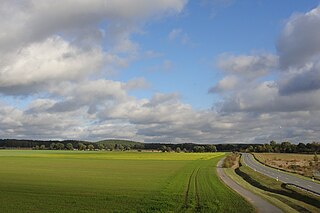
Theodor Fontane was a German novelist and poet, regarded by many as the most important 19th-century German-language realist author. Fontane is known as a writer of realism, not only because he was conscientious about the factual accuracy of details in fictional scenes, but also because he depicted his characters in terms of what they said or did and refrained from overtly imputing motives to them. He published the first of his novels, for which he is best known today, only at age 58 after a career as a journalist. His novels delve into topics that were more or less taboo for discussion in the polite society of Fontane's day, including marital infidelity, class differences, urban vs. rural differences, abandonment of children, and suicide. His novels sold well during his lifetime and several have been adapted for film or audio works. His characters range from lower-middle class to Prussian nobility.

Neuruppin is a town in Brandenburg, Germany, the administrative seat of Ostprignitz-Ruppin district. It is the birthplace of the novelist Theodor Fontane (1819–1898) and therefore also referred to as Fontanestadt. A garrison town since 1688 and largely rebuilt in a Neoclassical style after a devastating fire in 1787, Neuruppin has the reputation of being "the most Prussian of all Prussian towns".
Oberhavel is a Kreis (district) in the northern part of Brandenburg, Germany. Its neighbouring districts are : Mecklenburgische Seenplatte (district) in Mecklenburg-Western Pomerania, the districts of Uckermark and Barnim, the Bundesland of Berlin, and the districts of Havelland and Ostprignitz-Ruppin.

Lindow in der Mark, short: Lindow (Mark), is a town in the Ostprignitz-Ruppin district, in Brandenburg, Germany. It is located 14 km northeast of Neuruppin, and 29 km northwest of Oranienburg. The town is situated on an isthmus between the lakes Gudelacksee and Wutzsee.

Teupitz is a small town in the Dahme-Spreewald district, in Brandenburg, Germany. It is the administrative seat of the Schenkenländchen municipal association (Amt).

Karl Friedrich von dem Knesebeck was a Prussian field marshal and military adviser in the Napoleonic Wars, best known for designing the campaign plan of the Battle of the Nations and the subsequent invasion of France. As aide-de-camp to the king from 1813, and thereby his closest military advisor, he was a key figure in Prussia's military policy throughout the War of the Sixth Coalition and the subsequent Congress of Vienna.
Margrave Conrad I of Brandenburg was a member of the House of Ascania and a co-ruler of Brandenburg.

Spreewald gherkins are a specialty pickled cucumber from Brandenburg, which are protected by the EU as a Protected Geographical Indication (PGI).

Günter de Bruyn was a German author.

Ruppiner See is a lake in Ostprignitz-Ruppin, Brandenburg, Germany. At an elevation of 36.5 m (120 ft), its surface area is 8.25 km2 (3.19 sq mi). It is believed to have formed as a glacial tunnel valley.

The Rheinsberg Lake Region with its many great and small lakes, lies in the richly-varied, gently rolling, forested countryside between the villages of Rheinsberg, Menz and Fürstenberg/Havel in the north German state of Brandenburg. It lies just to the south of the Neustrelitz Little Lakes Region, but has no natural link to the waterbodies to the north. However, the Rheinsberg Lake Region is linked to the Neustrelitz lakes via the Wolfsbruch Canal and Lock, the Müritz-Havel Waterway and the Upper Havel Waterway. It drains southwards to the River Havel through the Rhin and is bounded by Ruppin Switzerland to the south. The overwhelming part of the region belongs to the Stechlin-Ruppiner Land Nature Park. The Stechlin Nature Reserve, created in 1938, is well known.

Rheinsberg Palace lies in the municipality of Rheinsberg, about 100 kilometres (62 mi) northwest of Berlin in the German district of Ostprignitz-Ruppin.

Wanderungen durch die Mark Brandenburg is a five-volume travelogue by the German writer Theodor Fontane, originally published in 1862–1889. It is his longest work and forms a bridge between his early career as a poet and his later novels. It covers the history, architecture, and people of the region as well as its landscape, and influenced the German Youth Movement of the early twentieth century.

The Rhinluch is a fen landscape in the German state of Brandenburg, bisected by the river Rhin to which it owes its name. This wetland region lies north of Fehrbellin in the county of Ostprignitz-Ruppin. The upper Rhinluch covers an area of about 23,000 hectares. The suffix luch is used to describe several wet areas in the state of Brandenburg, in which, prior to the advent of modern drainage systems, water remained largely stagnant rather than flowing.

Geographically, the Havelland is the region around which the River Havel flows in a U-shape between Oranienburg to the northeast and Rhinow to the northwest. The northern boundary of the Havelland is formed by the River Rhin and the Rhin Canal. In the history of Brandenburg, the Havelland represents a historic region.

Prince Frederick Henry Charles of Prussia was a Prussian prince and army officer.

The North Brandenburg Plateaux and Upland is a natural region in the northwest of Brandenburg and, to a lesser extent, the southwest of Mecklenburg-Vorpommern and northeast of Saxony-Anhalt in Germany. It is major unit group no. 77 in the natural regional divisions of Germany. The Brandenburg portion of the North Brandenburg Plateaux and Upland is largely coextensive with the natural region of Prignitz and Ruppin Land in the structural atlas of the state of Brandenburg.

The St. Nikolai church is the largest medieval church in Jüterbog, Brandenburg, Germany. The nave is a Brick Gothic hall church construction with field stone dual towers that dominate the cityscape. The church was first mentioned in 1307 and likely consecrated in 1488. The Patron saint is St. Nicholas of Myra.

Battle of Kremmer Levee was a final battle of Brandenburg–Pomeranian War, fought on 1 August 1332, on the Kremmer Levee, near the village of Kremmen. It was fought by forces of Pomerania-Stettin, Werle, and County of Schwerin, against the Margraviate of Brandenburg.

Lake Tornow is a lake in Ruppin Switzerland in Brandenburg, Germany. It is located east of Kunsterspring and south of Binenwalde and not far from the residential area of Tornow. It lies completely within the municipal boundaries of Neuruppin. The lake is a state waterway. It is 2.18 km (1.35 mi) wide and 1.57 km (0.98 mi) long, with an area of 124 ha and a maximum depth of 12 m (39 ft).


















